Red Desert (Wyoming)
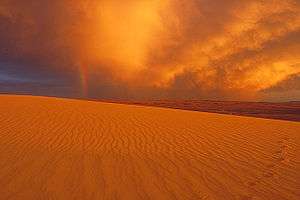
The Red Desert is a high altitude desert and sagebrush steppe located in south central Wyoming, comprising approximately 9,320 square miles (24,000 km²). Among the natural features in the Red Desert region are the Great Divide Basin, a unique endorheic drainage basin formed by a division in the Continental Divide, and the Killpecker Sand Dunes, the largest living dune system in the United States. In the 19th century, the Oregon, California and Mormon Trails tracked through the northern and western regions of the Red Desert after crossing the Continental Divide at South Pass. Today, busy Interstate 80 bisects the desert's southern region while gas field roads cross the desert.
The majority of the Red Desert is public land managed by the Rock Springs and Rawlins field offices of the U.S. Bureau of Land Management (BLM). The region is rich in oil, natural gas, uranium, coal and trona. An estimated 84% of the Red Desert has been "industrialized" by oil and gas drilling or by mining operations and associated roads.[1]
The Red Desert supports an abundance of wildlife, despite its scarcity of water and vegetation. The largest migratory herd of pronghorn in the lower 48 states and a rare desert elk herd, said to be the world's largest, live in the desert.[2] Ponds fed by summer snowmelt attract a wide range of migratory birds such as ducks, trumpeter swans, snowbirds, and white pelicans. Herds of feral horses known for their long manes and tails roam the area in large numbers, despite roundups and population control efforts by the BLM. The Hayden Expedition (1871) said Bighorn Sheep were numerous during their stay at the Honeycomb Buttes in the Red Desert, but today wild sheep are only found high in the mountain ranges and are rarely seen. Bison were also common and their skulls and horns can occasionally be found there.
Geography
Water
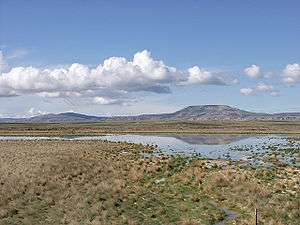
In a land known for its scarcity of precipitation, water has been a powerful force in shaping the Red Desert. Former rivers from the Paleocene and later epochs, and the ancient Lake Gosiute deposited between 10,000 feet (3,000 m) and 20,000 feet (6,100 m) of sediment in the Red Desert's geographic basin.[3]
Lake Gosiute began to fill the Red Desert for the first time in the early Eocene Epoch. Subsequent climate and tectonic activities during the lake's lifespan (four million years) saw repeated patterns of rising and falling water levels. Gosiute reached its maximum surface area of 15,000 square miles (39,000 km2) with its shoreline stretching into Utah.[3] Other times the lake evaporated completely.
Lake Gosiute left behind a high concentration of saline materials and a deep primal ooze of organic matter. The former produced today's highly valued mineral trona, while the latter created coal-bed methane gas, coal, and the world's largest known oil-shale deposit.[3] Energy sources have made the region the epicenter of today's natural gas boom in Wyoming.
The contemporary Red Desert watershed includes saline lakes and ponds that feature mud flats during wet years and salt pans in droughts. Intermittent streams, dependent primarily upon mountain snowmelt but accelerated by summer thundershowers, cut arroyos throughout the basin. Such small earth moving events, repeated over the eons, combined with the sculpting forces of wind have created the rugged landscape of buttes, pinnacles, gulches, and flats that characterize the Red Desert.[3]
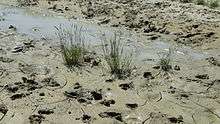
The Continental Divide branches to the desert's northwest and rejoins in the southeast, creating the Great Divide Basin, from which no surface water drains. Steamboat Mountain and other desert mesas or buttes provide seeps and springs that serve as water sources for small streams, such as Jack Morrow Creek. While the basin's interior waters are intermittent, the desert is bounded to the west by the Green River and to the east by the North Platte River.
If settlers in the Red Desert, such as the Mennonites who named Eden, Wyoming, were expecting rain follows the plow (a popular 19th century myth that plowed earth would generate rain),[4] they were sorely disappointed. Instead of a Promised Land, they found hard, brown desert ground that averages eight inches of precipitation a year. Most of that is snow. Fierce, seemingly endless western winds were sure to quickly evaporate any rain that does fall during the summer.
Farmers throughout the dry American West had to learn dry-land farming if they were to survive. This often meant relying upon irrigation to turn water upon the land. Efforts to reclaim areas of the Red Desert near Eden, for agriculture, date back at least to 1886, when Wyoming Territory issued water permits for settlers to divert the Big Sandy Creek, which drains to the Green River.[5]
Eden Irrigation and Land Company industrialized irrigation in 1907. The large scale water development project, financed by John M. Farson, Sons & Company, built a series of dikes on the Little Sandy and Big Sandy Creeks. Boosters for the company, seeking to attract settlers, distributed pamphlets trumpeting the desert as a land where "fruit orchards will thrive and corn will grow higher than a man's head", and, "the growing season in Eden Valley is as delightful as can be found in the country anywhere."[6]
Today two earth dams and 21 miles (34 km) of canals, with 91 miles (150 km) of lateral waterways, provide water to irrigate 17,010 acres (68.8 km2) under the authority of the Eden Valley Irrigation and Drainage District. Eden Valley irrigation diverts water that naturally flows to the Green River, the largest tributary of the Colorado River, which drains to Mexico's Gulf of California.
In 2009, the U.S. Army Corp of Engineers was poised to launch an environmental impact statement regarding a proposed 560 miles (900 km) pipeline to divert water from the Green River to population centers near Denver, Colorado. The $4 billion project targeted a route east from Flaming Gorge Reservoir across the Red Desert to Laramie, Wyoming, and then south to the Colorado Front Range.[7]
Killpecker Sand Dunes

Killpecker Sand Dunes stretch 55 miles (89 km) east from the Green River Basin across the Continental Divide into the Great Divide Basin and encompass approximately 109,000 acres (440 km2).[8] These living dunes, one of North America's largest fields,[3] owe their presence to two key factors:[9]
- The Big Sandy and Little Sandy Rivers northeast of Rock Springs, Wyoming where large volumes of sand accumulated on their banks during glacial melting from the Wind River Mountains.
- Westerly winds that during the past 20,000 years have moved the sand eastward across the continental divide to its present location.
A vital function of the dune fields is storing snowmelt and rain which support vegetation and wildlife. Water percolates deep into sand where it is safe from evaporating winds and sun. Such water is stored for access by basin large sagebrush and other vegetation depending upon the dunes' degree of stabilization. The few plant species that can survive on the active dunes include:[9]
- Blowout grass, Indian rice grass, needle-and-thread grass, prairie sandweed, rusty lupine, salina wildrye, sand lovegrass, sand muhly, sandhill muhly, and scurfpea.
Such plants help stabilize the sand by slightly reducing ground-level wind velocity. Stabilization is a cumulative process. Eventually the dunes may become stable as plant cover increases—assuming disruptive forces such as drought, fire, livestock and human traffic are not present.
Dune beetles and other insects in addition to small mammals such as shrews, white-footed mice and kangaroo rats inhabit the dunes. Their presence attracts owls, eagles, bobcats and other predators. Moreover, an oasis of short-lived summer ponds that occur in swales at the base of the dunes support migratory shore birds and waders, as well as large game animals such as elk. Cattle, sheep, and free roaming wild horses also frequent the ponds. The fresh water also provides a habitat for aquatic organism such as salamanders and freshwater shrimp.
Active sand dunes within the 10,500 acres (42 km2) of the Killpecker Sand Dunes area are open to off-road vehicles. Motorists are required to avoid the fresh water ponds scattered throughout the dunes.
Plant and wildlife
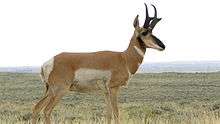
At first glance the Red Desert's largely dry, barren landscape seems an unlikely location for some 350 wildlife species and more than 1,000 plant species.[3] The sagebrush steppe and clump grass habitat support 40,000 to 50,000 pronghorn antelope, the largest migratory herd in the lower forty-eight states, similar sized herds of mule deer and the world's largest desert elk herd.[2][10]
What the desert lacks in concentrated animal habitat, it makes up in expanse. The Red Desert is home to the largest unfenced area in the continental United States.[11] Nearly three-quarters of the area is covered by sagebrush grassland.
The dominance of the region's evergreen sagebrush is a critical habitat for a variety of wildlife ranging from pronghorn which browse its leaves year round to small insects.[3] However, habitat is constrained by oil and gas roads along with drilling and mining. Sagebrush also provides cover for animals such as elk and the pygmy rabbit. Elk depend upon tall brush near Steamboat Mountain for shelter during spring calving season and elsewhere for shade during the heat of summer. Yet the broader impact of sagebrush upon the ecology is its function as a living snow fence. Windblown snow builds up on the lee side of the brush during winter. This effectively stores moisture that is released into the soil in late spring and early summer.
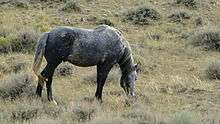
The result of the Red Desert's unique ecology is that wildlife is varied. Predators such as coyotes and the occasional mountain lion, grey wolf, swift fox, and kit fox are attracted by the area's mammals for feed. Pocket gophers, badgers, sage grouse, sage sparrows, and the sage thrasher are associated with the sagebrush habitat. The Red Desert is home to a range of burrowing animals. The white-tailed prairie dog, Great Basin spadefoot toad, tiger salamander, pygmy rabbits, and sagebrush lizards all go underground for protection from the desert's extreme weather and predators. Similarly, the burrowing owl nests and roosts underground, typically in burrows dug by prairie dogs. Migratory summer birds such as the white-faced ibis, trumpeter swan, and white pelican are found at snowmelt ponds on the desert floor and at temporal wetlands.[12]
High above the desert floor, the Ferris Mountains and Green Mountains rim the Red Desert to the northeast. The mountains' boreal environment reaches as high as 10,037 feet (3,059 m), in the case of Ferris Peak, and supports snowshoe hares, red squirrels, and pockets of big horn sheep. The high elevation with its cooler summer range attracts elk and mule deer. Prairie falcons, northern harriers and other raptors soar along mountain ridges and canyon rims looking for feed such as migratory mountain plovers, a small ground bird.
The mountain plover is one of three species protected by the Endangered Species Act present in the Red Desert.[13] The bald eagle and the black-footed ferret are also listed. However, the bald eagle is seldom seen in the desert because of the lack of streams or lakes with accompanying fish. Black-footed ferrets, which feed upon prairie dogs, are also rare.
Cultural and economic landscape
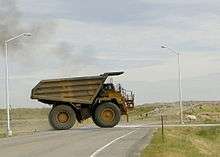
Scientists trace the story of human presence in the Red Desert back 12,000 years.[3] Striking evidence of early human inhabitants is seen in rock art found at the Boars Tusk, East Flaming Gorge, and Seedskadee areas. Researchers interpret the petroglyphs carved into rock at these sites as biographical, ceremonial, or spiritual expressions.[3] The Red Desert's Black Art petrogylph is thought to date back 11,500 years, according to anthropologist and cultural historian Russell L. Tanner who says the rock art may be the continent's oldest.[3]
Tanner refers to the Red Desert as a marketplace and crossroads during more recent times of interaction between nomadic Plains Indians, including Blackfeet, Crows, and Shoshone. He writes that rock art of the times, especially along the Green River, sprang from a melding of Indian cultures represented by imagery of the Plains Indian warrior tradition.[3] Other pre-historic evidence include Native American artifacts estimated to be more than 10,000 years old found in the Killpecker Sand Dunes, often in company with bison bones.[9]
.jpg)
Generations of American families, beginning in the 1840s, also left their mark upon the desert as they migrated westward along emigrant trails. The environmental impact of an estimated 350,000 pioneers and their wagon trains traveling through Wyoming between 1841 and 1868 is still visible today. In some cases, such as at Guernsey, wagon wheels wore ruts deep into solid sandstone. However, most trail ruts are less dramatic but still evidence of a people's history worn into the earth.
Historic trails used by nineteenth century stagecoaches are also part of the Red Desert's legacy. Of particular note, the Overland Stage initially followed the Platte River and the Oregon Trail to South Pass, but later shifted to a route across southern Wyoming. Stagecoach ruts in the desert are still visible in a variety of locations including north of Baggs. A short-lived gold rush in the northern mountains of the Red Desert beginning in 1867[14] led to stage and freight service from Point of Rocks on the Union Pacific Railroad north to South Pass City. There are segments of the Oregon, California, Mormon, and Pony Express trails, along with and archeological and fossil artifacts.[10]
A westward-looking nation in 1869 united its eastern and western shores with the First Transcontinental Railroad, whose route traversed the Red Desert. University of Wyoming historian Phil Roberts described the notion of building a transcontinental railroad as "today's equivalent of the mission to Mars: Big, expensive and impossible".[15] The preliminary survey for the railroad produced the first map of the Great Basin and Southern Wyoming, according to author Stephen E. Ambrose.[16] The Red Desert's lack of water presented a problem for steam locomotives of the time. The Union Pacific Company found reliable water by drilling deep artesian wells in the desert. Some of these railroad wells, such as at Wamsutter continue to supply much needed water today for residents and the influx of transitory oil-patch workers who live in temporary housing or "man camps".
Frontier expansion after the railroad's completion spurred new trade routes such as the New Fork Wagon Road that ran 80 miles (130 km) from Rock Springs, Wyoming to New Fork.[17] The New Fork Wagon Road connected isolated ranchers and settlements in northern Sweetwater and eastern Sublette Counties. The volume of cargo is evidenced by freighters of the time who were known to hitch as many as 18 horses to haul five freight wagons at once.[17]
The Union Pacific Railroad helped launch western towns along its route, like Wamsutter. Beginning in 1913, the Lincoln Highway connected them. The Lincoln Highway's coast-to-coast route also cut across the Red Desert as it passed through Wyoming. Interstate 80, nearly a half century later in 1956, replaced the Lincoln Highway as America's premier continental roadway. Today, Interstate 80 carries an estimated 11,000 vehicles across the desert daily.[18] The four-lane highway slices the desert into a north and south Red Desert in terms of wildlife migration.[3]
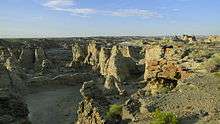
Other Expansion Era roads branched off from Union Pacific railheads at Point of Rocks, Green River and Bryan. These trade routes linked remote mining, ranching, and military settlements. Signs of these early trade routes, such as stage stations and freighter camps, are still visible in areas such as Freighter's Gap.[13]
Roadways used by modern-day freighters hauling oilfield supplies have created a spider web of dirt and gravel roads that crisscross the far reaches of the desert. BP, an energy company, reports service people associated with the Wamsutter gas field travel 800,000 miles (1,300,000 km) per month, down from 1,000,000 miles (1,600,000 km).[20] The explosion of natural gas wells drilled during Wyoming's most recent energy industry boom continues with more than 2,000 projected wells in the Wamsutter gas field to be operational by 2020.[21] The gas field encompasses an area in the Red Desert about 55 miles (89 km) long and 35 miles (56 km) wide.[20] Advances in drilling technology now allow grouping of multiple wells on a single drilling pad, thus reducing the footprint upon the land. Meanwhile, BLM expects the expansion in energy development to continue in the Red Desert including the Jack Morrow Hills of 600,000 acres (2,400 km2) near South Pass.[22]
Steve Dudley of Big Horn, Wyoming, shared his excitement on discovering the Red Desert: "Imagine star gazing into ink black skies where the light of the stars is the most illuminating feature of the nightscape, exploring the micro oases of melting ice layers insulted by shifting sands or climbing the desert's sand dunes."[10]
See also
References
- ↑ "Desert Values.". Friends of the Red Desert.
- 1 2 "Wyoming's Red Desert and the Pronghorn.". National Wildlife Federation.
- 1 2 3 4 5 6 7 8 9 10 11 12 Proulx (Editor), Annie (2008). Red Desert: History of Place. University of Texas Press.
- ↑ "Rain Follows the Plow". PBS.
- ↑ "U.S. Bureau of Reclamation Projects Within Wyoming's Portion of the Colorado River Basin". Wyoming State Water Plan.
- ↑ The Ultimate Wyoming Atlas and Travel Encyclopedia. Ultimate Press. 2003.
- ↑ "Pipeline plan takes shape". Casper Star Tribune. March 31, 2009.
- ↑ "Killpecker Sand Dunes". Public Lands Information Center.
- 1 2 3 Knight, Dennis (1996). Mountains and Plains: The Ecology of Wyoming Landscapes. Yale University Press. ISBN 978-0-300-06856-6.
- 1 2 3 Steve Dudley. "Wyoming's Red Desert is an amazing place". Cheyenne, Wyoming: Wyoming Tribune-Eagle. Retrieved May 19, 2015.
- ↑ "Site Profile: Red Desert". Audubon.
- ↑ "Field Guide: Wyoming's Red Desert". eNature Field Guides.
- 1 2 "Resources of the Red Desert and Jack Morrow Hills" (PDF). Western EcoSystems Technology, Inc. Center for the Wild West.
- ↑ "South Pass City". Wyoming State Parks, Historic Sites & Trails.
- ↑ State wants to attract more visitors to railroad monument, by JODI ROGSTAD. Associated Press. December 7, 2006.
- ↑ Ambrose, Stephen E (2001). Nothing like it in the world: the men who built the transcontinental railroad, 1863–1869. Simon and Schuster. ISBN 978-0-7432-0317-3.
- 1 2 "The New Fork Wagon Road: a Nineteenth Century Southwestern Wyoming Lifeline to the Union Pacific Railspur". By David Vlcek, Pinedale Field Office. U.S. Bureau of Land Management.
- ↑ "When a boom is bust". High Country News. February 14, 2004.
- ↑ http://reddesertfiles.wordpress.com/2009/11/24/red-deserts-adobe-town-wins-a-pardon-from-natural-gas-leasing/
- 1 2 "US Natural Gas: Lessons from BP's Tight Gas Facility in Wamsutter WY.". June 3, 2008.
- ↑ "BP Announces $2.2 Billion Expansion Of Wamsutter Natural Gas Field". BP press release.
- ↑ "Jack Morrow Hills Decision Ignores Public's Request for Conservation". Friends of the Red Desert.
External links
| Wikimedia Commons has media related to Red Desert (Wyoming). |
- National Wildlife Federation – Red Desert
- BLM Rock Springs Field Office Recreation Page
- Friends of the Red Desert
- Biodiversity Conservation Alliance – Red Desert
Coordinates: 41°49′29″N 108°17′12″W / 41.82472°N 108.28667°W